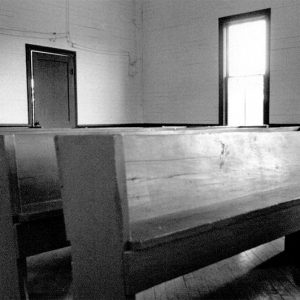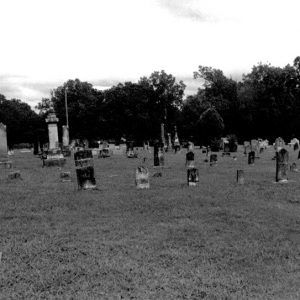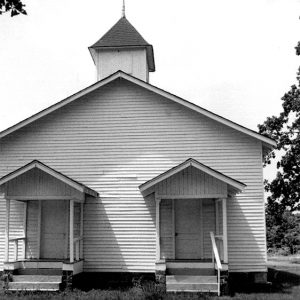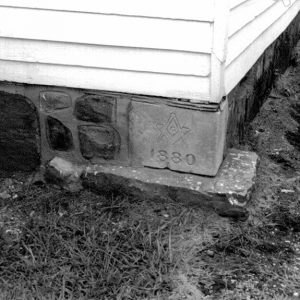calsfoundation@cals.org
Frenchman's Mountain Methodist Episcopal Church and Cemetery
aka: Cato United Methodist Church and Cemetery
Frenchman’s Mountain Methodist Episcopal Church, South, located at 13915 Frenchman Mountain Road in the Cato community on the Pulaski–Faulkner County line, is an 1880 wood-frame building altered to its current appearance in 1945. The church and its associated cemetery were listed on the National Register of Historic Places on October 22, 1976.
The Frenchman Mountain Methodist Episcopal Church, South, was organized in 1872, with the Reverend R. L. Kirkman ministering to the congregation’s needs, in addition to those of another dozen churches. A log structure was erected in the winter of 1872–1873 to serve as a church, with Kirkman preaching in it for the first time that spring. The Little Rock and Fort Smith Railroad company donated the land on which the church was built to the congregation on May 2, 1874.
In 1880, the log building burned down and a two-story wood-frame building was constructed, largely through the labors of Clark Wilkerson and Bud Easter. The new structure was soon the center of community life in Cato, with the congregation (which changed its name to Cato Methodist Episcopal Church, South, in 1907) worshiping on the first floor and local Masonic and International Order of Odd Fellows lodges and a Woodmen of the World camp gathering on the second.
By the mid-1940s, the fraternal organizations no longer met in the building, which was beginning to lean. The Methodists remodeled it in 1945, replacing the second floor with a steeple and adding two small porticos on the front elevation. The revamped building reflected the Craftsman style of architecture, which was exhibited in exposed rafter tails and triangular knee braces beneath the eaves on the building’s rear gable.
A cemetery was started adjacent to the church site soon after the congregation was formed, with the first burial dating to 1873. It displays a wide variety of funerary art, ranging from simple fieldstones to markers with sculptural elements and obelisks to manufactured zinc markers dating from the late eighteenth and early nineteenth centuries.
The Cato community suffered greatly from an expansion of Camp Joseph T. Robinson in 1940 and 1941, which removed the area’s most direct route to North Little Rock (Pulaski County). The church was declared inactive in 1962, with many members moving to the nearby Bethel United Methodist Church. But many former members continued to maintain the church and cemetery, and an annual homecoming in June, a Christmas service, and weddings and funerals were still held there.
A preservation organization, Cato Historic Church and Cemetery, Inc., was chartered to care for the building, and the United Methodist Church turned the property’s deed over to the group on January 27, 2012.
Frenchman’s Mountain Methodist Episcopal Church, South, and Cemetery was one of the earliest Arkansas properties to be listed on the National Register of Historic Places, and the nomination concluded with this statement: “Although revered as a shrine in the hearts of all of those who worshiped there or whose ancestors did and spoke so many times of the little white church, the main historical significance of the old church and cemetery is that it is a rare and perfect example of the old circuit rider’s church which was so very important in settling this part of the United States, and indeed the whole country.”
For additional information:
Kirk, Diana. “Frenchman’s Mountain Methodist Episcopal Church–South and Cemetery.” National Register of Historic Places registration form. On file at Arkansas Historic Preservation Program, Little Rock, Arkansas. Online at https://www.arkansasheritage.com/docs/default-source/national-registry/PU3062-pdf (accessed December 9, 2021).
Silva, Rachel. “Frenchman Mountain ME Church, South & Cemetery.” Walks Through History Script, Arkansas Historic Preservation Program. (accessed December 9, 2021).
Mark K. Christ
Central Arkansas Library System
 Historic Preservation
Historic Preservation Post-Reconstruction through the Gilded Age, 1875 through 1900
Post-Reconstruction through the Gilded Age, 1875 through 1900 Religion
Religion Cato Church Bathrooms
Cato Church Bathrooms  Cato Church Pews
Cato Church Pews  Frenchman's Mountain Cemetery
Frenchman's Mountain Cemetery  Frenchman’s Church
Frenchman’s Church  Frenchman’s Mountain Cornerstone
Frenchman’s Mountain Cornerstone  Frenchman’s Mountain Pulpit
Frenchman’s Mountain Pulpit  Frenchman’s Mountain Rear
Frenchman’s Mountain Rear 



Comments
No comments on this entry yet.